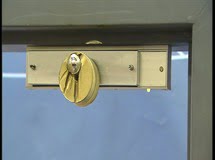MAGNETIC locks are perfect for many access control applications. They operate silently and have no moving parts, making them exceptionally reliable. Magnetic locks fail secure, have a modest footprint and offer a powerful physical seal.
These characteristics have made them the ubiquitous choice in a range of access control applications. But according to FSH’s Trevor Mackle, recent attacks also show they have vulnerabilities that his company has addressed with a couple of recent product releases.
Typically, Mackle doesn’t pull any punches with the designs of his new products. The new MEM anti-tamper lock and the retrofit anti-tamper plate are designed specifically to ward off attacks to which all magnetic locks are vulnerable.
“The issue we identified is attacks that exploit the characteristics of electromagnetic lock installation to defeat them,” Mackle explains.
“There are a number of ways this has occurred in recent attacks. In the first example, consider that on a standard magnetic lock, the armature plate is bolted through the door using a sex nut. The bolt goes all the way through the door and the rounded head of the nut is present on the unsecure side of the door.
“We are finding successful attacks are taking place where an angle grinder is being used to grind the heads off sex nuts,” says Mackle.
“With the heads of the nuts removed, a locked door can be opened – the headless bolts slides out of the bolt hole and the armature stays firmly fixed to the magnet maintaining a seal.”
According to Mackle, as the FSH design team set about working on ways to protect against attacks on sex nuts, Mackle realised it was not just angle grinders the designers needed to defend against.
“We identified the fact that not only could you grind the head of the sex nut off and open the door while maintaining a seal, exactly the same effect could be achieved by using a hole saw to cut around the sex nut,” he explains.
“Once the hole saw has been used to cut a disk-shaped hole completely through the door then the door can be opened with the disk of wood containing the sex bolt still connected to the armature and the armature still locked to the magnet. You have to see this to believe it,” Mackle explains.
“Having realised the vulnerabilities there 2 things to worry about when designing a new anti-tamper MEM lock. Firstly, the grinding off and then attacks using a hole saw.”
Mackle says FSH achieved its solution using an anti-tamper plate that fixes directly to the door.
“The anti-tamper plate is bolted and screwed onto the door, and the armature plate is attached to the anti-tamper plate, not to the door itself. This means if you grind off the sex nut the anti-tamper plate remains attached to the door.
“We are finding successful attacks are taking place where an angle grinder is used to grind the heads off sex nuts. With the heads of the nuts removed, a locked door can be opened – the headless bolts slides out of the bolt hole but the armature stays firmly fixed to the magnet maintaining a seal”
“Having overcome the business of cutting of the head of the sex bolt I then had to overcome attacks using a hole saw,” explains Mackle.
“In order to defeat hole saw attacks what we did was take 2 hardened steel pins and position them inside the anti-tamper plate running from end to end of the plate on the horizontal axis when installed on the door.”
According to Mackle, what happens is that as the hole saw penetrates the door and bites into the anti-tamper plate it uncovers the lengthways cavities in which the hardened pins are located. As the saw reaches and bites into them these hardened pins begin to spin and the saw is unable to penetrate them and in a short time becomes blunted.
“To enhance the resistance to attack even more, our new patented MEM anti-tamper magnetic lock has an early warning alarm built into it so if someone comes to the door and starts to pull on it we get an early warning alarm,” Mackle explains.
“The idea with the tamper switch is that if someone comes along and tries to grind off the head of the sex bolt head or cut through the door they will pull on the door and the tamper alarm will be activated, alerting monitoring stations or security staff,” he says.
“An important part of the solution was taking into account the ability to apply a higher level of security to legacy magnetic locks,” Mackle says.
“To achieve this we designed a retrofit plate. To install it you take off the existing armature plate, install the retrofit plate and then put the armature plate back on. You have to move the magnet slightly but it’s a straightforward upgrade that greatly increased security.”
According to Mackle, the new anti-tamper MEM-lock and armature plate are available now from FSH.
“These are important improvements to the security of magnetic locking installations,” says Mackle. “Installers and end users should think carefully about the vulnerability of their magnetic locking installations.”








